This article needs additional citations for verification .(June 2021) |
A titanium sublimation pump (TSP) is a type of vacuum pump used to remove residual gas in ultra-high vacuum systems, maintaining the vacuum.
This article needs additional citations for verification .(June 2021) |
A titanium sublimation pump (TSP) is a type of vacuum pump used to remove residual gas in ultra-high vacuum systems, maintaining the vacuum.
Its construction and principle of operation is simple. It consists of a titanium filament through which a high current (typically around 40 A) is passed periodically. This current causes the filament to reach the sublimation temperature of titanium, and hence the surrounding chamber walls become coated with a thin film of clean titanium. Since clean titanium is very reactive, components of the residual gas in the chamber which collide with the chamber wall are likely to react and to form a stable, solid product. Thus the gas pressure in the chamber is reduced. [1]
After some time, the titanium film will no longer be clean and hence the effectiveness of the pump is reduced. Therefore, after a certain time, the titanium filament should be heated again, and a new film of titanium re-deposited on the chamber wall. Since the time taken for the titanium film to react depends on a number of factors (such as the composition of the residual gas, the temperature of the chamber and the total pressure), the period between successive sublimations requires some consideration. Typically, the operator does not know all of these factors, so the sublimation period is estimated according to the total pressure and by observing the effectiveness of the outcome. Some TSP controllers use a signal from the pressure gauge to estimate the appropriate period.
Since the TSP filament has a finite lifetime, TSPs commonly have multiple filaments to allow the operator to switch to a new one without needing to open the chamber. Replacing used filaments can then be combined with other maintenance jobs. [1]
The effectiveness of the TSP depends on a number of factors. Amongst the most critical are; the area of the titanium film, the temperature of the chamber walls and the composition of the residual gas. The area is typically maximised when considering where to mount the TSP. The reactivity of the new titanium film is increased at lower temperatures, so it is desirable to cool the relevant part of the chamber, typically using liquid nitrogen. However, due to the cost of the nitrogen and the need to ensure a continuous supply, TSPs are commonly operated at room temperature. Finally the residual gas composition is important – typically the pump works well with the more reactive components (such as CO and O2), but is very ineffective at pumping inert components such as the noble gases [1] and methane (CH4). [2] Therefore, TSP must be used in conjunction with other pumps.
Other pumps which use exactly the same working principle, but using something other than titanium as a source are also relatively common. This family of pumps are usually called getter pumps or getters and typically consist of metals which are reactive with the components of the residual gas which are not pumped by the TSP. By choosing a number of such sources, most constituents of the residual gas, except for the noble gases, can be targeted.
When mounting the TSP in the chamber, a number of important considerations must be made. First, it is desirable that the filament can deposit on a large area. However, one must take care that the titanium is not deposited onto anything it can damage. For example, electrical feed-throughs containing ceramic insulators will fail if the titanium forms a conducting film which bridges the ceramic insulator. Samples may become contaminated by titanium if they have line-of-sight to the pump. Also, titanium is a very hard material, so titanium film which builds up on the inside of the chamber may form flakes which fall into mechanical components (typically turbomolecular pumps and valves) and damage them.
Many chambers containing TSPs also have an ion pump. Often the ion pump provides a good location for the TSP, and some manufacturers promote the use of both types together. [3] Furthermore, TSPs have been shown to be effective against the regurgitation effects of ion pumps. [4]

Chemical vapor deposition (CVD) is a vacuum deposition method used to produce high-quality, and high-performance, solid materials. The process is often used in the semiconductor industry to produce thin films.

Pressure measurement is the measurement of an applied force by a fluid on a surface. Pressure is typically measured in units of force per unit of surface area. Many techniques have been developed for the measurement of pressure and vacuum. Instruments used to measure and display pressure mechanically are called pressure gauges,vacuum gauges or compound gauges. The widely used Bourdon gauge is a mechanical device, which both measures and indicates and is probably the best known type of gauge.
In semiconductor manufacturing plasma ashing is the process of removing the photoresist from an etched wafer. Using a plasma source, a monatomic substance known as a reactive species is generated. Oxygen or fluorine are the most common reactive species. Other gases used are N2/H2 where the H2 portion is 2%. The reactive species combines with the photoresist to form ash which is removed with a vacuum pump.
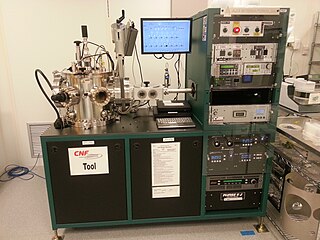
In physics, sputtering is a phenomenon in which microscopic particles of a solid material are ejected from its surface, after the material is itself bombarded by energetic particles of a plasma or gas. It occurs naturally in outer space, and can be an unwelcome source of wear in precision components. However, the fact that it can be made to act on extremely fine layers of material is utilised in science and industry—there, it is used to perform precise etching, carry out analytical techniques, and deposit thin film layers in the manufacture of optical coatings, semiconductor devices and nanotechnology products. It is a physical vapor deposition technique.

A vacuum pump is a type of pump device that draws gas particles from a sealed volume in order to leave behind a partial vacuum. The first vacuum pump was invented in 1650 by Otto von Guericke, and was preceded by the suction pump, which dates to antiquity.
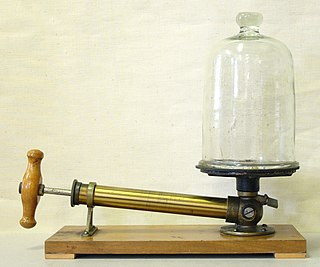
A vacuum is space devoid of matter. The word is derived from the Latin adjective vacuus meaning "vacant" or "void". An approximation to such vacuum is a region with a gaseous pressure much less than atmospheric pressure. Physicists often discuss ideal test results that would occur in a perfect vacuum, which they sometimes simply call "vacuum" or free space, and use the term partial vacuum to refer to an actual imperfect vacuum as one might have in a laboratory or in space. In engineering and applied physics on the other hand, vacuum refers to any space in which the pressure is considerably lower than atmospheric pressure. The Latin term in vacuo is used to describe an object that is surrounded by a vacuum.
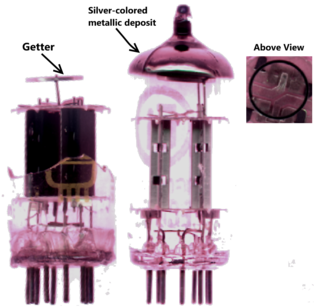
A getter is a deposit of reactive material that is placed inside a vacuum system to complete and maintain the vacuum. When gas molecules strike the getter material, they combine with it chemically or by absorption. Thus the getter removes small amounts of gas from the evacuated space. The getter is usually a coating applied to a surface within the evacuated chamber.
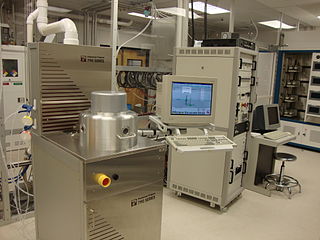
Reactive-ion etching (RIE) is an etching technology used in microfabrication. RIE is a type of dry etching which has different characteristics than wet etching. RIE uses chemically reactive plasma to remove material deposited on wafers. The plasma is generated under low pressure (vacuum) by an electromagnetic field. High-energy ions from the plasma attack the wafer surface and react with it.
Ultra-high vacuum is the vacuum regime characterised by pressures lower than about 1×10−6 pascals. UHV conditions are created by pumping the gas out of a UHV chamber. At these low pressures the mean free path of a gas molecule is greater than approximately 40 km, so the gas is in free molecular flow, and gas molecules will collide with the chamber walls many times before colliding with each other. Almost all molecular interactions therefore take place on various surfaces in the chamber.
Degassing, also known as degasification, is the removal of dissolved gases from liquids, especially water or aqueous solutions. There are numerous methods for removing gases from liquids.
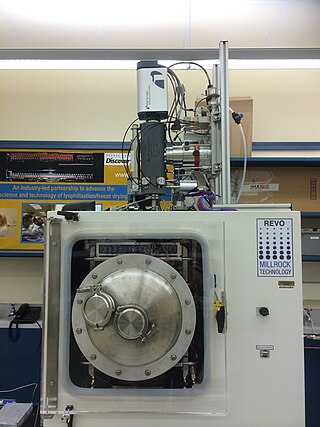
A residual gas analyzer (RGA) is a small and usually rugged mass spectrometer, typically designed for process control and contamination monitoring in vacuum systems. When constructed as a quadrupole mass analyzer, there exist two implementations, utilizing either an open ion source (OIS) or a closed ion source (CIS). RGAs may be found in high vacuum applications such as research chambers, surface science setups, accelerators, scanning microscopes, etc. RGAs are used in most cases to monitor the quality of the vacuum and easily detect minute traces of impurities in the low-pressure gas environment. These impurities can be measured down to Torr levels, possessing sub-ppm detectability in the absence of background interferences.

In vacuum tubes and gas-filled tubes, a hot cathode or thermionic cathode is a cathode electrode which is heated to make it emit electrons due to thermionic emission. This is in contrast to a cold cathode, which does not have a heating element. The heating element is usually an electrical filament heated by a separate electric current passing through it. Hot cathodes typically achieve much higher power density than cold cathodes, emitting significantly more electrons from the same surface area. Cold cathodes rely on field electron emission or secondary electron emission from positive ion bombardment, and do not require heating. There are two types of hot cathode. In a directly heated cathode, the filament is the cathode and emits the electrons. In an indirectly heated cathode, the filament or heater heats a separate metal cathode electrode which emits the electrons.
Chemical beam epitaxy (CBE) forms an important class of deposition techniques for semiconductor layer systems, especially III-V semiconductor systems. This form of epitaxial growth is performed in an ultrahigh vacuum system. The reactants are in the form of molecular beams of reactive gases, typically as the hydride or a metalorganic. The term CBE is often used interchangeably with metal-organic molecular beam epitaxy (MOMBE). The nomenclature does differentiate between the two processes, however. When used in the strictest sense, CBE refers to the technique in which both components are obtained from gaseous sources, while MOMBE refers to the technique in which the group III component is obtained from a gaseous source and the group V component from a solid source.
Electron-beam physical vapor deposition, or EBPVD, is a form of physical vapor deposition in which a target anode is bombarded with an electron beam given off by a charged tungsten filament under high vacuum. The electron beam causes atoms from the target to transform into the gaseous phase. These atoms then precipitate into solid form, coating everything in the vacuum chamber with a thin layer of the anode material.

Evaporation is a common method of thin-film deposition. The source material is evaporated in a vacuum. The vacuum allows vapor particles to travel directly to the target object (substrate), where they condense back to a solid state. Evaporation is used in microfabrication, and to make macro-scale products such as metallized plastic film.
An ion pump is a type of vacuum pump which operates by sputtering a metal getter. Under ideal conditions, ion pumps are capable of reaching pressures as low as 10−11 mbar. An ion pump first ionizes gas within the vessel it is attached to and employs a strong electrical potential, typically 3–7 kV, which accelerates the ions into a solid electrode. Small bits of the electrode are sputtered into the chamber. Gasses are trapped by a combination of chemical reactions with the surface of the highly-reactive sputtered material, and being physically trapped underneath that material.

Sputter deposition is a physical vapor deposition (PVD) method of thin film deposition by the phenomenon of sputtering. This involves ejecting material from a "target" that is a source onto a "substrate" such as a silicon wafer. Resputtering is re-emission of the deposited material during the deposition process by ion or atom bombardment. Sputtered atoms ejected from the target have a wide energy distribution, typically up to tens of eV. The sputtered ions can ballistically fly from the target in straight lines and impact energetically on the substrates or vacuum chamber. Alternatively, at higher gas pressures, the ions collide with the gas atoms that act as a moderator and move diffusively, reaching the substrates or vacuum chamber wall and condensing after undergoing a random walk. The entire range from high-energy ballistic impact to low-energy thermalized motion is accessible by changing the background gas pressure. The sputtering gas is often an inert gas such as argon. For efficient momentum transfer, the atomic weight of the sputtering gas should be close to the atomic weight of the target, so for sputtering light elements neon is preferable, while for heavy elements krypton or xenon are used. Reactive gases can also be used to sputter compounds. The compound can be formed on the target surface, in-flight or on the substrate depending on the process parameters. The availability of many parameters that control sputter deposition make it a complex process, but also allow experts a large degree of control over the growth and microstructure of the film.
Electron-beam-induced deposition (EBID) is a process of decomposing gaseous molecules by an electron beam leading to deposition of non-volatile fragments onto a nearby substrate. The electron beam is usually provided by a scanning electron microscope, which results in high spatial accuracy and the possibility to produce free-standing, three-dimensional structures.

Materials for use in vacuum are materials that show very low rates of outgassing in vacuum and, where applicable, are tolerant to bake-out temperatures. The requirements grow increasingly stringent with the desired degree of vacuum to be achieved in the vacuum chamber. The materials can produce gas by several mechanisms. Molecules of gases and water can be adsorbed on the material surface. Materials may sublimate in vacuum. Or the gases can be released from porous materials or from cracks and crevices. Traces of lubricants, residues from machining, can be present on the surfaces. A specific risk is outgassing of solvents absorbed in plastics after cleaning.

Low-energy plasma-enhanced chemical vapor deposition (LEPECVD) is a plasma-enhanced chemical vapor deposition technique used for the epitaxial deposition of thin semiconductor films. A remote low energy, high density DC argon plasma is employed to efficiently decompose the gas phase precursors while leaving the epitaxial layer undamaged, resulting in high quality epilayers and high deposition rates.